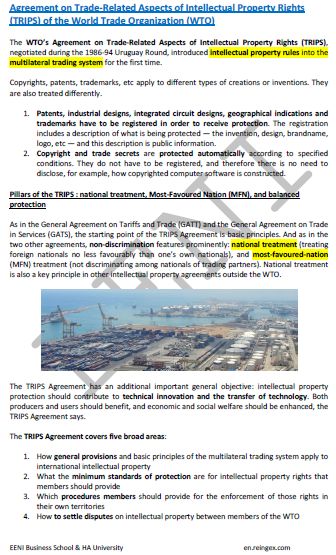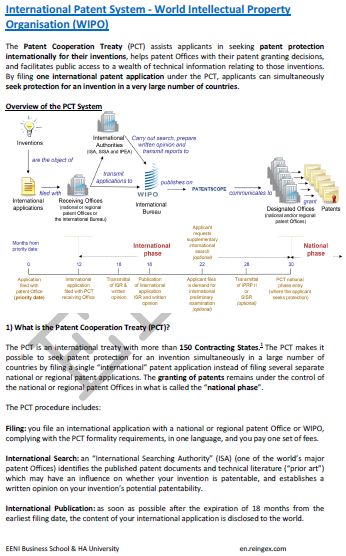Intellectual Property Rights (IPR) WTO
Agreement: Trade-Related Aspects of Intellectual Property Rights (TRIPS, WTO)
The importance of the Agreement on Trade-Related Aspects of Intellectual Property Rights (TRIPS) of WTO lies in the fact that it allows the incorporation of a whole series of regulations related to intellectual property in the multilateral trading system.
According to WTO “the protection of intellectual property must contribute to technical innovation and technology transfer”
- Introduction to Trade-Related Aspects of Intellectual Property Rights
- Copyright and rights related to copyright
- Industrial property
- Infringement of intellectual property rights
- The role of the World Intellectual Property Organization (WIPO)
- Agreement on Trade-Related Aspects of Intellectual Property Rights (TRIPS)
of the World Trade Organization (WTO)
- The Pillars of the TRIPS Agreement
- Other international agreements
- Paris Convention for Protection of Industrial Property (patents, industrial designs, etc.)
- Berne Convention for Protection of Literary and Artistic Works (copyright)
- Case study: Intellectual property rights in the United States-Mexico-Canada Agreement (USMCA/NAFTA 2.0)
- AI and Global Trade
- Digital Trade and Cross-Border E-Commerce
- AI in Global Strategy and Decision-Making
Sample - Trade-Related Aspects of Intellectual Property Rights:

The educational aims of the Subject “Trade-Related Aspects of intellectual property rights” are the following:
- To understand the fundamental concepts related to Trade-Related Aspects of Intellectual Property Rights
- To learn about role of the World Intellectual Property Organization (WIPO) and the different international intellectual property registration systems (Lisbon, The Hague, Madrid...) of WIPO
- To learn the importance and pillars of the Agreement on Trade-Related Aspects of intellectual property rights (TRIPS) of WTO

The Subject “Trade-Related Aspects of Intellectual Property Rights” is included within the curriculum of the following academic programs at EENI Global Business School:
Masters: International Business, Foreign Trade and Marketing.


Languages: 
 Derechos de propiedad intelectual
Derechos de propiedad intelectual
 Droits de propriété intellectuelle
Droits de propriété intellectuelle
 Intellectual Property Rights.
Intellectual Property Rights.
Trade-Related Aspects of Intellectual Property Rights.
Intellectual creations are protected through intellectual property rights. These might be:
- Copyright and related rights (sheet music, books, software...)
- Industrial property
Industrial property include: trademarks, patents, trade secrets, designs, geographical indications, website domains, database protection...
The main objective of intellectual property rights is to protect the author, consumers and promote a fair competition in addition to favoring the innovation (inventions). The Intellectual property rights also allow negotiating a payment for use to the owner of the right.
In Foreign Trade, intellectual property rights ensure the transfer of technology (licenses, Investments Abroad, joint-ventures...).
TRIPS agreement seeks to standardize the industrial property rights in the member countries of WTO through the development of international standards of common use.
These minimum agreements on the protection of intellectual property rights are usually improved and extended in the free trade agreements.
The Agreement on Trade-Related Aspects of Intellectual Property Rights (TRIPS) also defines the mechanisms for resolving the differences between the countries.
The pillars of the Agreement on Trade-Related Aspects of Intellectual Property Rights (TRIPS):
- National treatment
- Most favored nation treatment (MFN)
- Balanced protection
The Paris Convention for Protection of Industrial Property, signed in 1883, includes the protection of utility models, trademarks, trade names, patents, industrial models, unfair competition and geographical indications.

(c) EENI Global Business School (1995-2025)
Top of this page










 WhatsApp
WhatsApp
